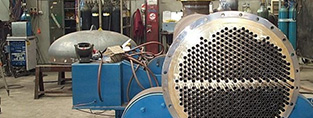
- (03) 5909 8218
- enquiry@fusionweld.com.au
Hazardous Effects of Gas Leaks from Unmaintained Pressure Vessels
September 18, 2017

The adherence to a specific set of design codes ensures an installed pressure vessel fulfils its purpose as a capable containment unit. What a bitter pill it is to swallow, then, if that superbly designed engineering asset is placed under a second rate maintenance program. Imagine a worst case scenario. A leak is developing in the unmaintained pressure vessel. Loaded with gas, what are the hazardous effects of this leak?
A Gas Leak Primer
The ill-informed masses are sadly unaware of a few basic facts about gas leaks in pressure vessels. First of all, some of the more popular gas mediums are odourless and invisible. Safety-oriented manufacturers add sulphide-based compounds to the gas so that a leak is easier to notice. It's that rotten eggs smell that warns nearby folk of a containment breach. However, there are instances where a caustic gas can cause immediate respiratory problems, then there are gas leaks that starve the brain of oxygen. Finally, there are system breaches that ignite as explosive fireballs. The first order of business, then, is to provide notice of the contained medium. Furthermore, spark-proof housings, warning systems, and personal protection systems should be on hand as a certified safety mechanism, one that intelligently counteracts the potential gas leak hazard.
Maintenance Programs Reduce Hazards
A hazardous substance fact sheet informs site management heads. It informs and prepares the on-site workers, tells local emergency services what to expect should that worst case scenario event occur, and equips the maintenance program with the wherewithal to reduce this potential. Without the preventative care strategy, even the finest engineering practices can be defeated. Overload conditions, as one example, weaken pressure equipment. The gear, built to handle a predetermined pressure range, plus a set transient overhead, weakens imperceptibly when it expands. The maintenance routine documents such events and creates a time-based narrative, one that expresses those imperceptible design limitation overloads as a comprehensible system deterioration chart. Identified in this manner, any and all corrective measures are taken before a leak breaches a weld seam or fractured section of sheet metal.
Left unmaintained, caustic substances leak from damaged pressure vessels. They cause shortness of breath and eye irritation. If they're truly toxic, acute respiratory distress is likely. Flammable gases are obviously the worst hazards, with a single spark acting as the trigger that causes a destructive explosion or a life-threatening fire. However, don't underestimate the odourless, invisible substances that starve a location of breathable air when they leak from pressure vessels. Symptoms of this last exposure hazard include dizziness, nausea, and loss of consciousness, at which point the leak will kill its victim.
Contact Details
Fusion - Weld Engineering Pty Ltd
ABN 98 068 987619
1865 Frankston Flinders Road,
Hastings, VIC 3915
Ph: (03) 5909 8218
Optimized by NetwizardSEO.com.au
Recent Posts
- Compressed Hydrogen Storage Vessels: Material Selection, Design & Australian Standards
- Welding QA/QC in Oil & Gas Pressure Vessel Fabrication – Ensuring Code Compliance
- AS1210 vs ASME VIII Pressure Vessel Code: Key Differences for Australian Projects
- Mitigating Hydrogen-Induced Cracking in Pressure Vessels: Engineering and Material Strategies
- Storage Tank Solutions Australia: Field-Erected, Prefabricated & Self-Bunded Explained
- Reducing Environmental Risks: Self-Bunded Tanks in Australian Oil & Gas Operations
- Precision in Production: How Pressure Vessels Are Manufactured for Industrial Safety
- Shell & Tube Heat Exchangers: Improve Thermal Control & Energy Recovery in Petrochemical & Pharmaceutical Plants
- In-Service Inspection for Compressed Air Receivers for Power Plant Shutdown Prevention
- Power Plant Pipe Spooling Fabrication – Get Rapid, Code-Compliant Spools Ready for Installation
- Field Erected Tanks: Safe, Reliable On-Site Fuel Storage Solutions in Australia
- Custom Pressure Vessel Fabrication for Flammable Gases
Posts 2025
- Compressed Hydrogen Storage Vessels: Material Selection, Design & Australian Standards
- Welding QA/QC in Oil & Gas Pressure Vessel Fabrication – Ensuring Code Compliance
- View all articles…
Posts 2024
- Large Process Vessels: Optimising the Design for Maximum Efficiency [2025]
- Pressure Equipment Management System Installation: Detect Equipment Faults Early
- View all articles…
Posts 2023
- Pressure Piping System Inspection: A Gift of Safety for the Holidays
- Deaerator Inspections by Fusion-Weld Engineering and How They Reduce System Downtime
- View all articles…
Posts 2022
- How Fusion Weld Keeps Up With AS-NZS ISO 9001:2008 Standard
- Boiler Equipment Safety Inspection During the Summer Season
- View all articles…
Posts 2021
- Avoid These Factors and Practices that Contribute to Sealing Damage in Pressure Vessels
- Do's And Don'ts Of Industrial Boiler Inspection And Maintenance From Fusion-Weld
- View all articles…
Posts 2020
- What are the Risks and Hazards Involved in Pressure Vessel Equipment?
- How to Know if Your Pressure Equipment Needs Repair or Replacement?
- View all articles…
Posts 2019
- Factors that Contribute to Pressure Vessel Failure
- Pressure Vessel Regulations in Australia: What are the Mandatory Requirements?
- View all articles…
Posts 2018
- Pros and Cons of Spherical vs. Cylindrical Pressure Vessels
- What are the Different Hazard Levels in Pressure Vessels?
- View all articles…
Posts 2017
- Transportable Pressure Vessels: The Importance of Inspection and Safety Checks
- Fracture Mechanics and Stress Analysis of Cracks in Pressure Vessels
- View all articles…
Posts 2016
Posts 2015
- What Are Deaerators & Feedwater Vessels?
- Precautions and Safety for Compressed Air Receiver Vessels
- View all articles…
Posts 2014
- Demonstrating In-process Inspection Procedures
- Static Grounding Practices and Standards
- View all articles…